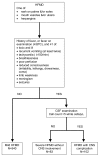Identification and validation of clinical predictors for the risk of neurological involvement in children with hand, foot, and mouth disease in Sarawak
- PMID: 19152683
- PMCID: PMC2637878
- DOI: 10.1186/1471-2334-9-3
Identification and validation of clinical predictors for the risk of neurological involvement in children with hand, foot, and mouth disease in Sarawak
Abstract
Background: Human enterovirus 71 (HEV71) can cause Hand, foot, and mouth disease (HFMD) with neurological complications, which may rapidly progress to fulminant cardiorespiratory failure, and death. Early recognition of children at risk is the key to reduce acute mortality and morbidity.
Methods: We examined data collected through a prospective clinical study of HFMD conducted between 2000 and 2006 that included 3 distinct outbreaks of HEV71 to identify risk factors associated with neurological involvement in children with HFMD.
Results: Total duration of fever >or= 3 days, peak temperature >or= 38.5 degrees C and history of lethargy were identified as independent risk factors for neurological involvement (evident by CSF pleocytosis) in the analysis of 725 children admitted during the first phase of the study. When they were validated in the second phase of the study, two or more (>or= 2) risk factors were present in 162 (65%) of 250 children with CSF pleocytosis compared with 56 (30%) of 186 children with no CSF pleocytosis (OR 4.27, 95% CI2.79-6.56, p < 0.0001). The usefulness of the three risk factors in identifying children with CSF pleocytosis on hospital admission during the second phase of the study was also tested. Peak temperature >or= 38.5 degrees C and history of lethargy had the sensitivity, specificity, positive predictive value (PPV) and negative predictive value (NPV) of 28%(48/174), 89%(125/140), 76%(48/63) and 50%(125/251), respectively in predicting CSF pleocytosis in children that were seen within the first 2 days of febrile illness. For those presented on the 3rd or later day of febrile illness, the sensitivity, specificity, PPV and NPV of >or= 2 risk factors predictive of CSF pleocytosis were 75%(57/76), 59%(27/46), 75%(57/76) and 59%(27/46), respectively.
Conclusion: Three readily elicited clinical risk factors were identified to help detect children at risk of neurological involvement. These risk factors may serve as a guide to clinicians to decide the need for hospitalization and further investigation, including cerebrospinal fluid examination, and close monitoring for disease progression in children with HFMD.
Figures


References
-
- Pallansch MA, Ross RP. In: Field's Virology. 4. Knipe DM, Howley PM, Griffin DE, Lamb RA, Martin MA, Roizman B, Straus SE, editor. Vol. 1. Lippincott Williams & Wilkins; 2001. Enteroviruses: Polioviruses, Coxsackieviruses, Echoviruses, and Newer Enteroviruses; pp. 723–775.
Publication types
MeSH terms
Grants and funding
LinkOut - more resources
Full Text Sources
Other Literature Sources
Molecular Biology Databases

